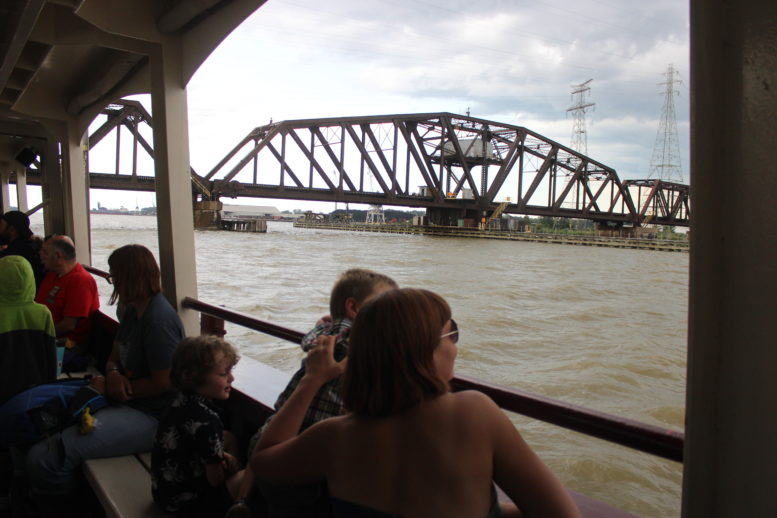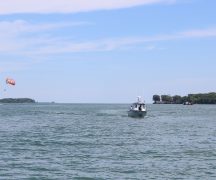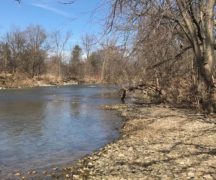By DAVID DUPONT
BG Independent News
Floating on the Maumee River heading northeast toward Maumee Bay, observers get a sense both of the river’s potential and its problems.

Cheryl Rice talks to passengers on the Clean Water Cruise.
From the cruise boat Sandpiper, several dozen passengers on the Clean Water Cruise can see plenty of recreation – fishermen, kayakers, motor boaters, and jet skiers, though no one foolhardy enough to swim in the brown river.
Seagulls and Canada geese fly overhead, ducks float by the shore where the occasional heron stands at attention before lofting gracefully into the air.
The scenery on the shoreline is industrial, broken up by large patches of scrub brush. The grain towers, full of the product of the surrounding farmland waiting to be loaded on freighters docked alongside, are testament to the agricultural enterprise that’s so central to the Maumee’s vast 7-million-acre watershed.
The Sandpiper is cruising through water that’s infused with soil that’s been washed away from those acres.
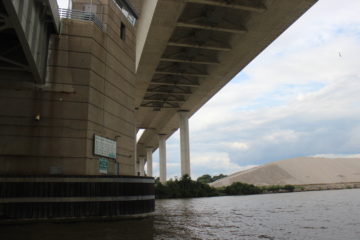 “That’s somebody’s soil,” says Cheryl Rice, of the federal Natural Resources Conservation Service, an arm of the US Department of Agriculture, noting the brown hue of the river.
“That’s somebody’s soil,” says Cheryl Rice, of the federal Natural Resources Conservation Service, an arm of the US Department of Agriculture, noting the brown hue of the river.
The cruise was more than a Saturday lark on the river. Sponsored by the Maumee Area of Concern Advisory Committee, the Clean Water Cruise was intended to educate residents about efforts to clean up the Maumee and by extension Lake Erie and to enlist them in helping in those efforts.
The Great Lakes contains a fifth of the earth’s fresh water, and the Maumee watershed sends more water into the lakes than any other source.
Kris Patterson, executive director of Partners for Clean Streams, said the cruise was intended to “create better stewards for our watershed.”
“What we do on land affects our water.”
Jamie Kochensparger, the outreach director with Lucas County Soil and Water Conservation, said a wide range of daily activities can have an impact on water.
Picking up after pets so their waste doesn’t get into the water is important, as are a range of household activities to conserve water. Collecting roof water in a rain barrel to use for watering lawns helps.
So does checking how much water is wasted just by running it until it gets hot. Kochensparger said she discovered she was losing a half gallon of water in her kitchen sink. Now she saves that water in a jug for other uses.
Not letting water run constantly while brushing your teeth helps, as does taking shorter showers.
She also encouraged the planting of species native to the area that are better suited to the local environment.
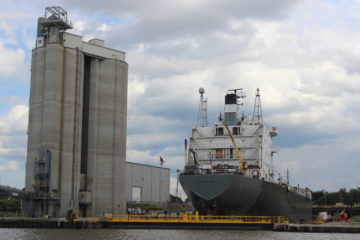 Paul Bockstahler, of the Toledo Waterways Initiative, spoke about government investment in reducing pollution going into rivers. The initiative started in 2002, and should be completed by 2020. The aim is to reduce the overflow of untreated sewage into area waterways including the Maumee.
Paul Bockstahler, of the Toledo Waterways Initiative, spoke about government investment in reducing pollution going into rivers. The initiative started in 2002, and should be completed by 2020. The aim is to reduce the overflow of untreated sewage into area waterways including the Maumee.
The project, he said, is more than 80 percent complete. When completed, he said, 650 million gallons of untreated sewage will no longer find its way into the water system.
One of the projects under construction, a storm water holding basin, was near the Jefferson Avenue dock where the Sandpiper launched.
Heavy rains, which are becoming more common, can force storm water into treatment facilities for sanitary sewer treatment. These can overwhelm the system resulting in discharges of untreated water into the river.
Bockstahler said this is being remedied by expanding the Bay View Water Treatment plant to keep the two wastewater streams separate. Holding basins are part of that. Storm water does not require the higher level of treatment that the effluent from sanitary sewers does.
Bockstahler said that the plant uses the same system, bugs that consume and clean the waste, that nature uses only in a more intense way.
The water that flows from the plant comes out cleaner than the river water it goes into, he said. That attracts fish and other wildlife to the waters just offshore from the plant.
Rice, of the USDA’s Natural Resource Conservation Service, said it is important for her to know about those efforts to address urban sources of pollution.
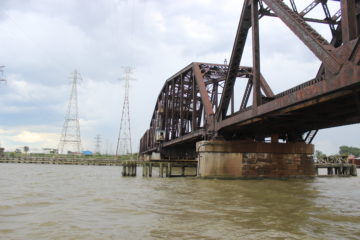 She’s charged with working with farmers in the watershed, and they often feel like they are blamed for Lake Erie’s problems. Rice said she’s sure to tell them that others are working on the issue as well.
She’s charged with working with farmers in the watershed, and they often feel like they are blamed for Lake Erie’s problems. Rice said she’s sure to tell them that others are working on the issue as well.
Enlisting farmers to reducing pollution is essential. More than 70 percent of the land in the Maumee watershed is used for agriculture. Soybeans, corn, and wheat are the main crops. Wheat production, however, is declining because of low prices, Rice said.
Especially problematic is the phosphorus that’s put on fields as fertilizer to promote the growth of crops. When that phosphorus washes into the lake, it promotes the growth of algae. In 2014 that algae bloom turned toxic, shutting off water to the Toledo metro area.
There are steps farmers can take to stem the flow, and many are early adopters of these conservation measures, while others lag behind.
Still there’s no one perfect solution. No-till practices are generally considered beneficial, but are not always workable. Buffer areas that absorb and hold surface runoff after large storms are useful for surface water, but don’t protect groundwater.
Using animal waste to fertilize fields is a way to use that waste, but it can cause problems if not properly applied. New state regulations will prohibit the spreading of manure on fields when the ground is frozen and can’t absorb it.
But, Rice said, changes in weather patterns are also changing the way these nutrients spread within the system, meaning new approaches need to be found.
Those wishing to join the effort, Partners for Clean Streams offers both guidance and volunteer opportunities. The group’s website is: PartnersforCleanStreams.org.

